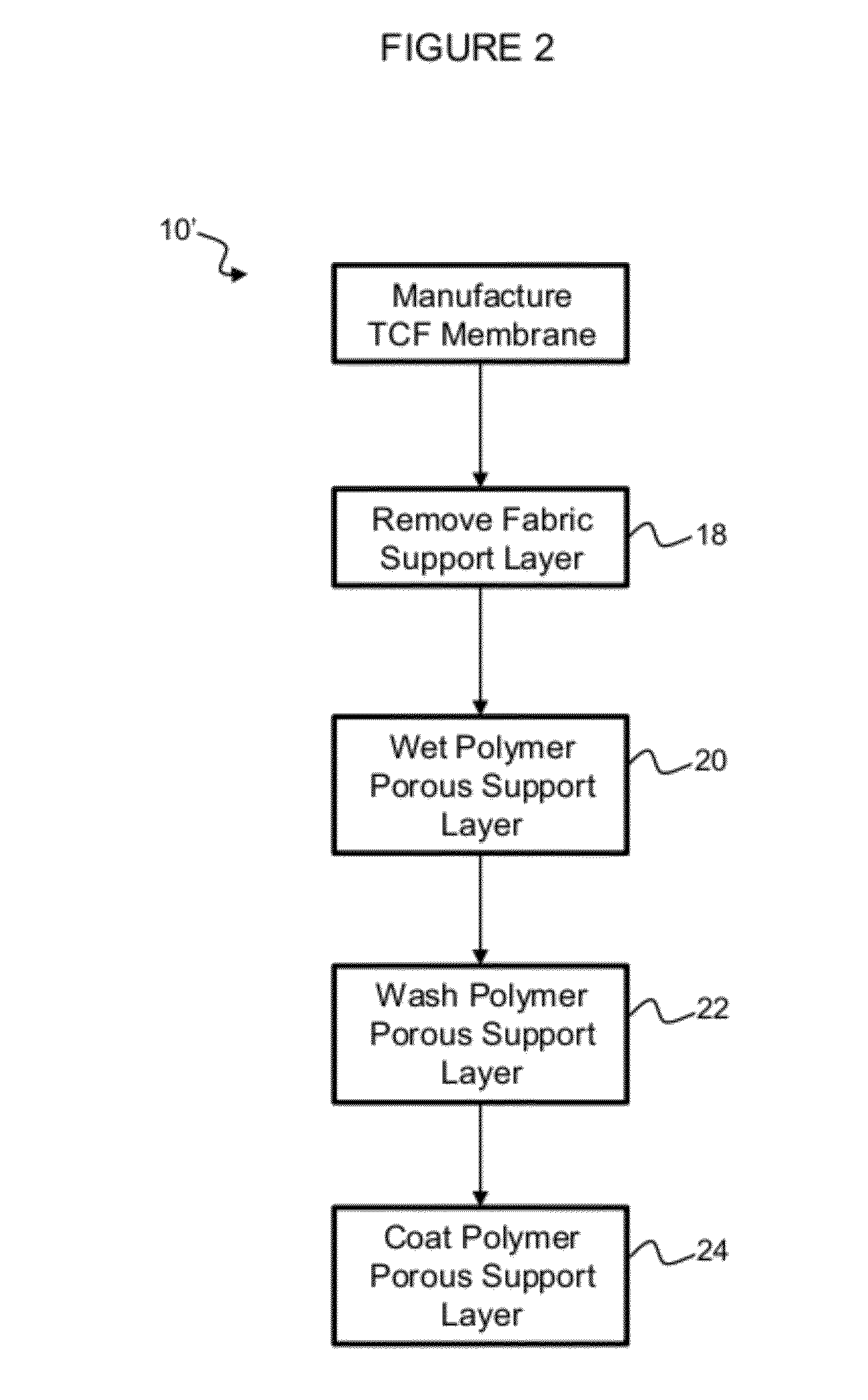Method of modifying thin film composite membrane support structures for engineered osmosis applications
a technology of composite membranes and support structures, applied in membranes, filtration separation, separation processes, etc., can solve the problems of unique mass transfer limitation of osmotic flow processes, detrimental chemical properties necessary for a suitable support layer to produce these asymmetric structures, and reduce the osmotic pressure difference across the selective layer of the membrane, so as to improve the hydrophilicity of poly(dopamine) modified membranes and increase the effect of hydraulic permeability
- Summary
- Abstract
- Description
- Claims
- Application Information
AI Technical Summary
Benefits of technology
Problems solved by technology
Method used
Image
Examples
example 1
[0104]A method of modifying thin film composite membrane support structures (10) is shown in FIG. 1. The membrane support layers are first wetted (12) with isopropyl alcohol (IPA) to allow the poly(dopamine) to coat the inner pores of the membrane. isopropyl alcohol does not negatively affect membrane performance and is easily removed and replaced with water during a subsequent washing step.
[0105]Following wetting the support layers, the isopropyl alcohol is rinsed (14) out of the membrane using a series of deionized water baths. The deionized water baths are chilled to prevent the nucleation of air bubbles on the surface and into the pores of the membrane. In the lab scale experiments, the membranes are then stored in chilled deionized water prior to coating.
[0106]After the isopropyl alcohol has been removed from the membrane, the support layers are coated with poly(dopamine) (16). The coating step was conducted at room temperature, though alternate temperatures may enhance coating...
example 2
[0108]Another method of modifying thin film composite membrane support structures (10) is shown in FIG. 2. The fabric support layer is stripped from the membrane (18). The exposed surface of the polymer porous layer is wetted with isopropyl alcohol (20), rinsed with deionized water (22), and then coated with poly(dopamine) (24). This technique has been used in laboratory experiments with commercial membranes. In particular, Dow Water Process Solutions BW30 and SWXLE membranes were prepared for a PDA coating by wetting out with isopropyl alcohol by soaking it for 1 hour and then rinsed in 3 successive water baths for 45 minutes. They were then coating with PDA for either 1 hour or 42 hours in a special cell which allowed for 2 reservoirs separated by the membrane. The reservoir containing the PDA coating solution was exposed only to the membrane supports layers.
example 3
ormance Experiments
[0109]The osmotic flux of these membranes was measured in a cross-flow osmosis test system with a draw solution flowrate of 1 LPM (approximately 0.25 m / s), at 23° C., with no pressure differential across the membrane. The osmotic flux was measured with the membrane in both the FO and PRO orientations. The draw solution concentration was changed from 0.05 M to 1.5 M sodium chloride during these experiments. The mass of the draw solution was measure autonomously once every minute and related to a volume change in the solution to determine the water flux.
PUM
| Property | Measurement | Unit |
|---|---|---|
| temperature | aaaaa | aaaaa |
| temperature | aaaaa | aaaaa |
| temperature | aaaaa | aaaaa |
Abstract
Description
Claims
Application Information
 Login to View More
Login to View More - R&D
- Intellectual Property
- Life Sciences
- Materials
- Tech Scout
- Unparalleled Data Quality
- Higher Quality Content
- 60% Fewer Hallucinations
Browse by: Latest US Patents, China's latest patents, Technical Efficacy Thesaurus, Application Domain, Technology Topic, Popular Technical Reports.
© 2025 PatSnap. All rights reserved.Legal|Privacy policy|Modern Slavery Act Transparency Statement|Sitemap|About US| Contact US: help@patsnap.com



